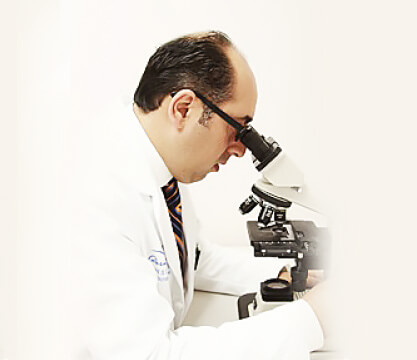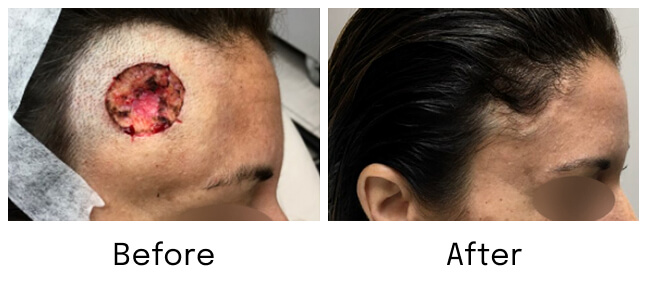Mohs Micrographic Surgery in Los Angeles

Mohs Micrographic Surgery
Is the most advanced and effective treatment for skin cancer available today. The procedure is performed by specially trained Mohs surgeons such as Dr. Daniel Behroozan who have completed at least one additional year of fellowship training (in addition to the physician’s three-year dermatology residency) under the tutelage of a Mohs College member. Members of the American College of Mohs Surgery such as Dr. Behroozan, have completely an additional year of training specifically in the Mohs surgery technique following the completion of a traditional dermatology residency. This is a competitive fellowship position given only to the top dermatology candidates each year and culminates in certification by the American College of Mohs Surgery. This is distinguished from members of a different society known as the American Society for Mohs Surgery. Members of this other society are not required to perform additional training in Mohs surgery and therefore less qualified and experienced to perform these types of intricate procedures.
Thanks to Dr. Behroozan’s special training in surgery, pathology, and reconstruction, his Mohs surgery patients have the highest success rate of all treatments for skin cancer – up to 99%. As a board certified dermatologist and the founder of the Dermatology Institute of Southern California, Dr. Daniel Behroozan is committed to patient safety and making sure their needs are met as a top priority. With extensive experience in cosmetic dermatology, Dr. Behroozan is determined to preserve patients’ appearance, ensuring minimal scarring for each Mohs procedure he performs, and therefore the best surgical and cosmetic outcomes possible. With years of training and professional experience at his Beverly Hills location, Dr. Behroozan is able to repair surgical wounds in the most efficient way possible in order to provide optimal healing time and the best cosmetic results.
The Mohs Technique
Initially developed by Dr. Frederic E. Mohs, the Mohs procedure is a state-of-the-art treatment that has been continuously refined over 70 years. With the Mohs technique, Dr. Behroozan is able to see beyond the visible disease, to precisely identify and remove the entire tumor layer by layer while leaving the surrounding healthy tissue intact and unharmed. As the most exact and precise method of tumor removal, it minimizes the chance of re-growth and lessens the potential for scarring or disfigurement.
The Mohs technique is also the treatment of choice for cancers of the face and other sensitive areas as it relies on the accuracy of a microscopic surgical procedure to trace the edges of the cancer and ensure complete removal of all tumors down to the roots during the initial surgery.
Mohs Micrographic Surgery is the most effective and precise method for treating basal cell and squamous cell skin cancers. However, it can also be used to treat less common tumors including melanoma.
Mohs Surgery Vs. Excision
Surgical excision is a technique performed by dermatologists that involves removing the skin affected by cancer, while at the same time cutting away normal appearing skin around the area as well. This is to make certain that the cancerous cells have been completely removed. This is also done to reduce the possible risk of recurrence.
On the other hand, Mohs surgery leaves healthy tissue intact when extracting the cancerous skin cells. Patients can benefit from Mohs surgical technique in the following circumstances:
1. The cancer is in an area where it is important to preserve healthy tissue for maximum functional and cosmetic results, such as eyelids, nose, ears, lips, fingers, toes, or genitals.
2. The cancer was treated previously and recurred
3. Scar tissue exists in the area of the cancer
4. The cancer is large
5. The edges of the cancer cannot be clearly defined
6. The cancer is growing rapidly or uncontrollably
When compared to the Mohs technique, traditional excision may come up short. Although there are significant benefits to the Mohs surgery, excision can be useful when treating less sensitive areas of the body. In areas where skin is looser and uncomplicated sewing can be performed, traditional excision can be a positive technique to use. If cancerous cells need to be removed from for example, a patient’s eyelid or nose, then the precision of the Mohs technique can be advantageous. However, if the cancerous removal is needed on the arm, where it is less complicated to remove and stitch, then tradition excision may be more practical and just as efficient.
What to Expect during Mohs Surgery
Mohs surgery is usually an outpatient procedure performed in a physician’s office. Typically, it starts early in the morning and can be completed the same day, depending on the extent of the tumor and the amount or reconstruction necessary. Local anesthesia is administered around the area of the tumor so the patient is awake during the entire procedure.
Reconstruction – Repairing the Wound
Dr. Behroozan is also trained in reconstructive procedures and often will perform the necessary reconstruction to repair the wound. As soon as the affected area is declared cancer-free, Dr. Behroozan will discuss post-surgical options with the patient such as:
- A small, simple wound may heal by itself.
- A slightly larger wound may be closed with stitches.
- Larger wounds may require a skin graft or a flap.
- If the tumor is very large, another surgeon with special skills may be called upon to assist with reconstruction.
Post-Surgical Management
Post-surgical check-ups are recommended in order to monitor the patient’s progress and spot any possible cancer recurrence in a timely manner. Since two of five patients with one skin cancer will develop another within five years, follow up is extremely important for early detection of any new lesions.
Why choose a fellowship trained Mohs Surgeon?
You want your skin cancer treatment to be performed with the highest standards of quality and competency. The American College of Mohs Surgery is the only organization that requires its members, after their years of residency training, to successfully complete an extensive fellowship of at least one full year of hands-on training in the Mohs procedure under the supervision of a highly qualified instructor.
Successful Results
Because the Mohs Micrographic Surgery process surgery features a systematic microscopic search that traces skin cancer down to its roots, it offers the highest chance for complete removal of the tumor while sparing the normal tissue surrounding it.
Clinical studies conducted at various national and international medical institutions – including the Mayo Clinic, the University of Miami School of Medicine and Royal Perth Hospital in Australia – demonstrate that Mohs surgery provides five-year cure rates exceed 99 percent for new cancers, and 95% for recurrent cancers.
Mohs Surgery Technique
Dr. Behroozan, a top specialist in the field of dermatology, uses his years of experience to personally assess his patient’s skin concerns and make a customized treatment plan to suit their needs. Committed to making his patient’s personal goals and appearance a priority, Dr. Behroozan takes great care to make sure that scarring from surgery is as minimal as possible. Furthermore, Dr. Behroozan and his Beverly Hills Mohs surgery team are determined to find the best skin care solutions and procedure based on each patient’s individual case.











